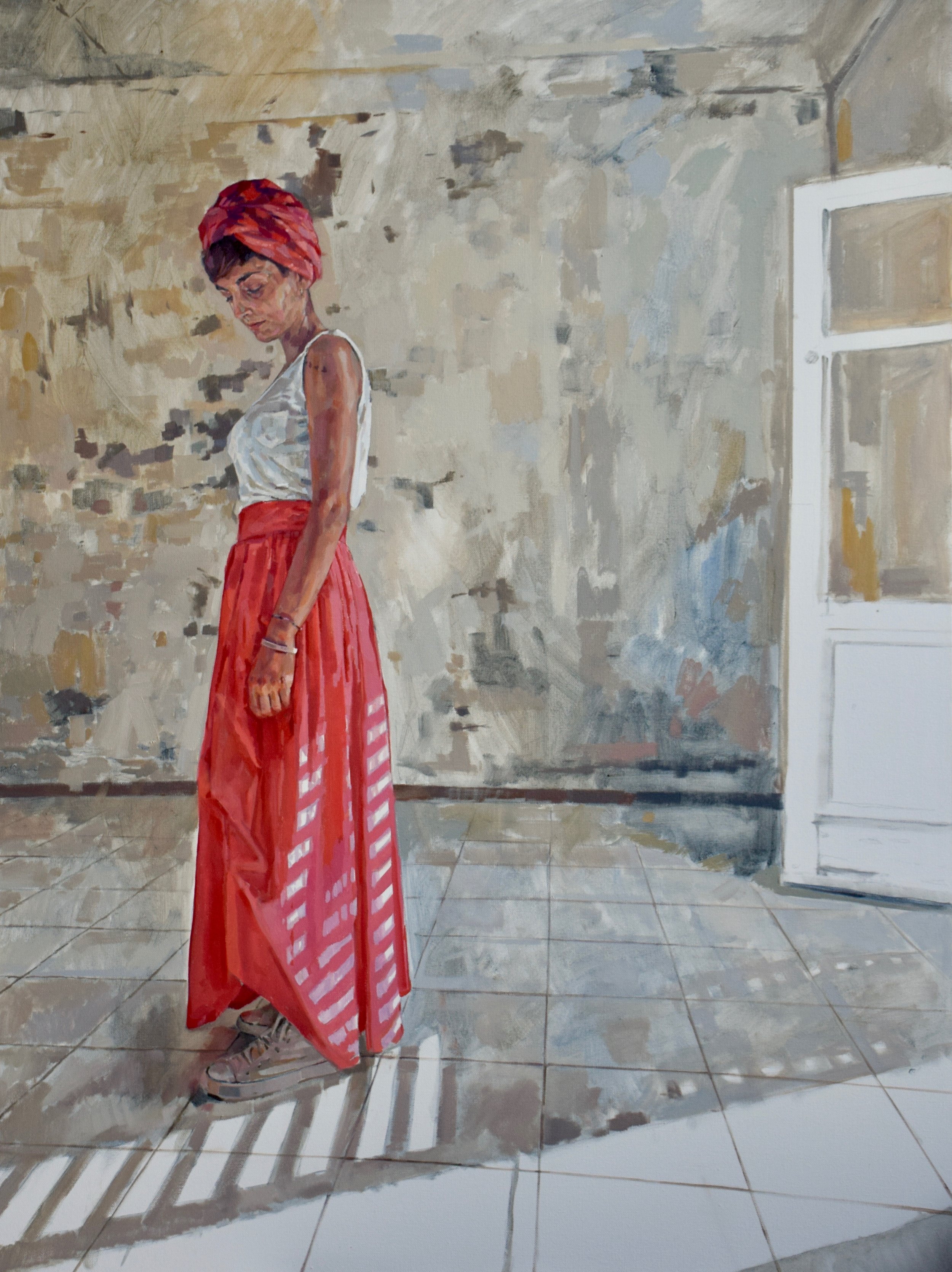Gregory Mason: Paradoxes in the Paint
Opening Thursday, 5th April and running through 28th April in London, Greg Mason’s solo show of luscious oil paintings at Cass Art Islington, After Shock (2018) explores the paradox of aftermath and rebuilding embedded within the paradox of his technical approach. The work in this exhibition focuses on the small town of Farindola in central Italy, which experienced a severe earthquake in January, 2017, which, in turn, triggered an avalanche that killed twenty-nine people. In 2017, Mason resided and worked in a home damaged by the tragedy as part of an artist residency in Farindola, providing a cherished insight into the town, its inhabitants, and their altered lives.
Prior to this body of work, solitary women and expansive skies primarily constituted Mason’s subjects. The works he painted in Farindola, while more specific, share Mason’s paradoxical technical qualities. Mason paints loosely, yet applies paint thinly, his open forms highly deliberate and anticipatory of their next veil of color. His accuracy of drawing reveals itself subtly: in the correct perspective of tiles receding in Giulia, for example, or in the correct proportions of limbs akimbo in his many nudes. 'Once you accept the limitations of working in oil,' Mason states, 'you are opened up to a world of endless possibilities.'[1] Mason paints confidently and maximizes oil paint’s range of opacity, and thus the paint itself—despite his paintings’ lean layers and careful compositions—does not appear fragile, but rather fluid and tenable.
Mason’s chips of color recall the work of Paul Cézanne, particularly his Mont Sainte-Victoire. In Gardner’s Art Through the Ages, Fred S. Kleiner writes that “Instead of employing the Impressionists’ random approach when he was face-to-face with nature, Cézanne developed a more analytical style. He sought to order the lines, planes, and colours that comprised nature” (837).[2] Kleiner adds, “By applying to the canvas small patches of juxtaposed colours, some advancing and some receding, Cézanne created volume and depth in his works” (Ibid). Kleiner concludes that “Cézanne created what might be called, paradoxically, an architecture of colour” (838).[3] One might say the same for Mason’s calculated yet charismatic approach, though, according to Kleiner, Cézanne’s paradox rests in the relationship between colour and structure, rather than Mason’s relationship between paint application and structure.
Paul Cézanne's Mont Saint-Victoire (1902-4)
The Farindola paintings employ a more somber palette than Cezanne’s Mont Sainte-Victoire—which delights in local colour—yet vibrate more chromatically than Mason’s usual work. In particular, Giulia exemplifies this. The white strip of floor illuminated by afternoon light contrasts starkly with the muted tones of the painting. The strip of floor’s pristine flatness is such that it may not read just as bright light, but rather as recently scrubbed. Dusty Converse sneakers peek from under Giulia’s conspicuous coral skirt, probably worn while picking up or mourning, nearly hidden—but not totally—by her bright ensemble. Her dingy shoes betray the labor and homeliness of the spotless floor. Perhaps she, like the other subjects, makes a gargantuan effort to scrupulously mop her memory clean of the tragedy. Another, crueler metaphor exists in that miraculously white strip of floor: it impersonates the path of the avalanche itself, its whiteness so cool that it conjures snow and sharp air.
Whereas Giulia turns her face down dejectedly towards the strip of floor, Paolo faces the opposite direction. He stands with folded, contemplative hands, his blue suit a pillar against the ragged gold wall behind him. Like Giulia’s bohemian skirt and turban, Paolo’s suit offers no connection with his setting, but rather acts in defiance of the surrounding damage. But that pristine, cold white appears again, not simply on the floor and around the frame of the door, but in Paolo’s sharp white shirt. 'I definitely think that artists … notice and highlight the things that others don’t see,' Mason says.[4] Patches of this white linger in each of Mason’s After Shock paintings, imbuing them with the same devastating memory despite the subjects’ colorfully manifested desire to move beyond the tragedy.
Thus, Greg Mason achieves a paradox within a paradox in the works he created for “After Shock”. The first and most immediate level—of his technical originality and handling of paint—allows his work to visually pulse without jeopardizing its formal integrity. However, the second level—of his deferential conceptual balance between aftermath and rebuilding, before and after, life after death—poignantly, hauntingly lends humanity. 'One does not substitute oneself for the past, one merely adds to it a new link,' said Cézanne. Mason’s Farindola paintings humbly move through the chain of his subjects’ lives, awaiting their rebirths amidst the rubble. Very fitting for an exhibition opening shortly after Easter.
'After Shock' runs from 5th April to 28th April, 2018 at Cass Art Islington.
[1] 'Artist Interview: Greg Mason, Professional Oil Painting Ambassador for Cass Art,' Cass Art Blog, 24 Jan., 2018,
[2] Fred S. Kleiner, Gardner’s Art Through the Ages: A Global History (Thomson Wadsworth: Boston, 2009), p.669.
[3] Ibid., p.818.
[4] 'Artist Interview: Greg Mason, Professional Oil Painting Ambassador for Cass Art,' Cass Art Blog, 24 Jan., 2018,


